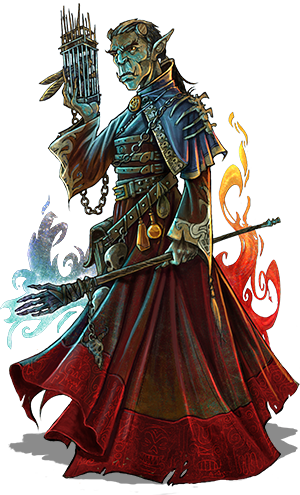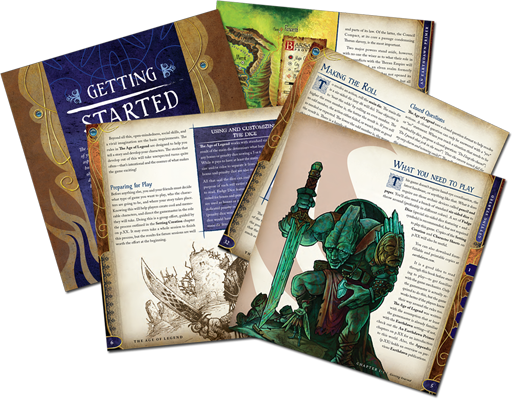
Earthdawn: The Age of Legend (Vagrant Workshop)
Vagrant Workshop. The small-press publisher is going to release Earthdawn: The Age of Legend, a rules-lite alternative for the high-fantasy roleplaying classic Earthdawn, within the next few months.
We played the original game a few times when Earthdawn first came out in the early 90’s. Earthdawn offered a unique and compelling re-interpretation of classic fantasy and Dungeons & Dragons tropes. Dungeons (kaers) are there for a reason, the typical fantasy races are familiar and spiced up with something special, and magic items are the stuff of legend – not only a modifier.
Unfortunately, Earthdawn’s original game mechanics are far too crunchy for my tastes. The forthcoming game, Earthdawn: The Age of Legend, may offer for me a new opportunity to visit Barsaive and meet the disturbing Blood Elves and wild Troll Sky Raiders again.
Carsten Damm, author of Earthdawn: The Age of Legend, answered some questions to satisfy my curiosity.
How would you briefly describe Earthdawn and what is your personal relationship to this game?
Broadly described, the world of Earthdawn is a fantasy world recovering from a magic apocalypse that was brought over the world by otherworldly demons. People hid underground for centuries, nations and empires rose and fell with this event. The setting is packed with detail, and one of its features is that it gives reason to many tropes unexplained in other settings. There is a lot more to it, naturally, but that’s me trying to be as brief as possible.
My personal relationship with the game spans nearly 20 years, and (apart from actually running the game) started with publishing fan material back in the 90’s. My devotion didn’t go unnoticed, and I became Line Developer for the game at some point in 2005. We pioneered publishing it via Print-on-Demand in a Classic version (two big tomes of rules, several sourcebooks and adventures), bringing the material back to print after most of it was not available anymore. We later managed to bring the game back into the stores using the traditional print and distribution methods with Earthdawn Third Edition. Both times, we tried to make the game available as a whole, so the new material we developed was accompanied by a number of updated reprints. It was a great time, we had a lot of fun back then.
I stepped back from being Line Developer in 2011, mainly because I needed more time raising my kids. Things had started to go downhill with the publisher as well a while earlier, so I and a few others dropped out a while after. We continued on our own, publishing smaller games with a greatly reduced workload under the Vagrant Workshop and Pro Indie labels.
Who or what is Vagrant Workshop?
We’re a group of independent game designers, publishing “small” roleplaying games—some of our own, some by other authors, and a few translations (that’s where our german label, Pro Indie comes in).
Anyway, we’re dedicated to quality, only releasing games and supplements we love and believe in. And we take our time to do so—there are no publishing schedules, deadlines or anything like that. Some of the team have worked on Earthdawn with me back then, others came in along the way. We’ve been connected for years and know what we can expect of each other. We love what we do, everything else is secondary.
What are the most important features of the Earthdawn setting?
The main characters in Earthdawn are epic heroes. They start out being special and capable, and continue becoming extremely powerful. One of the core features of the stories told in Earthdawn, and the games supporting the setting, is that they build their own legends. Fame, glory, epic battles, conspiracies, rebellious politics, tempting evil, great dragons—the characters are right there in the middle of it all, as the shining heroes mundane people look up to and call for help. Dealing with that kind of responsibility is also part of your story.
Another feature is one I mentioned earlier: the detail and believability of the setting. The world has a rich background offering explanations for all the tropes you are used to from other fantasy settings—and adds a few twists on top. Dungeons are there for a reason, everything has a history. The original game mechanics (provided by FASA’s own Step System) were closely intertwined with many of the setting features—often considered inseparable by the fans.
There is, of course, the wealth of material that has been published for the game world over the years. The writing and coherence of it is superb, and—even if most of it was created in the 90s—continues to be a great source of inspiration.
How does your new Earthdawn: The Age of Legend system support these features?
The main focus in the design phase was to capture that specific “Earthdawn feeling” that made us play this game all those years—but without the crunch and all those excessive ruling baggage the original game has accumulated over the years. The game is light and easy to play, and lets do you all the things you’d you expect from a game of Earthdawn—our playtesters (most of them veterans of the orginal game) said we succeeded with that. I’m certain many people out there will agree!
The core premise—actively building a character’s legend—is at the heart of the game. We also tailored the system to the setting, so that they interlock. The rulebook has been written with the fluff in mind, so you can use it with everything that was published before (opposed to reprinting it all again). People who still have the game can use their old books, new people can get what they want in digital form.
Your Earthdawn: The Age of Legend is based on Freeform/Universal RPG. The free download of the system has only 23 pages. Your book will have more than 230 pages. What happened and what can fans expect?
Consider that the generic FU you find on RPGNow just covers the core mechanics with a bunch of generic options on how to handle various things. There is no real depth to it, no campaign play, no artwork, no sample creatures, no world description, and so on. The basic FU rules leave all that to you.
What we did was to take these options and adapt them to the Earthdawn setting. One example: in the generic FU, you can spend FU Points to „use stunts and powers,“ along with a short suggestion of what these could be in the same sentence. That’s it—there are no practical examples, or even lists to choose from. In Earthdawn: The Age of Legend, we actually developed what these are and how you can learn them—these are your talents and spells connected to a variety of Disciplines and so on. Again, just one example to get you a better idea of where the page count comes from.
Check this article for a rundown of the book’s chapters and compare that against the generic FU document.

Earthdawn: Age of Legends: Troll Nethermancer (Image: Vagrant Workshop)
Every character (Adept) in Earthdawn is somewhat magical and the original system is quite crunchy. What can fans of your Earthdawn: The Age of Legend expect to see as far as races, abilities, powers, etc.? What does a character look like?
The races at your disposal (Dwarf, Elf, Human, Ork, Troll, T’skrang, Obsidiman, and Windling) are the ones you know. We have fifteen Disciplines coming in three categories (Fighters, Wanderers, and Magicians). These are well-known, except that we added the Shaman to the set to get five Disciplines in each category.
If you don’t define anything else using your main descriptors (we call them tags), Earthdawn: The Age of Legend assumes that part of your character resembles the common stereotype. So, for example, if you’re playing a dwarf, there’s no need to choose “Thick-headed” as your Personality tag—because that’s stereotypical for dwarfs. The same is true for the Disciplines, which come with a stereotypical way of viewing the world—your task during character creation is to see what makes your character adds to it or makes him different from that stereotype. There’s a range of suggestions for this, so it becomes pretty easy to create unique characters—and play them, as each tag dictates a certain behavior.
The four Circles of experience (Novice, Journeyman, Warden, and Master) loosely resemble what you know as power levels from the Step System. Each comes with a variety of talents and spells to learn and choose from. The way you do this knows no further boundaries, however, so you can learn what you need and customize your character’s abilities as you enter each of the four Circles.
Talents and spells enable you to do things mundane people cannot, how you use these abilities is up to you (and group consensus). There are actually only a few abilities granting you straight bonus dice, so you need to use them in creative ways to gain bonuses to your closed questions. For example, the Air Dance talent lets you glide over the ground, which certainly grants you a bonus if your question is directed at dodging a blow—but it will also help you to skate somewhere or perform other stunts where such gliding would be helpful. Likewise, a Flame Arrow could be used to hurt an opponent, but also to set something on fire or send a signal to someone else.
The talents and spells we provide in the book were inspired by the ones known from the various Step System editions, although they are fewer in number and more broadly defined. We encourage the use of these in unexpected ways, and the system is great in allowing just that without getting in the way. You won’t find excessive rules narrowing these effects down—you apply them as you see fit within the game style you and your group prefers.
There are a few more things making up a character, but these things form the core pretty much. We’re working on a preview featuring a sample character at the moment, and will present that soon on the homepage.
In my experience, Earthdawn is combat heavy and offers a lot of magical options. As far as I know, the Freeform/Universal RPG does not have any kind of Hit Points (etc.). How does Earthdawn: The Age of Legend handle combat?
The basic FU system offers Conditions to describe your character’s state. We added a feature that lets you mark Conditions as severe injuries—Wounds. Each character has a limited number of these, which need to be checked off in order to take out or kill you (or an opponent, for that matter).
Combat is different, but much shorter and adrenaline-laden—because you don’t just roll your dice to see how hard you’ve hit, what kind of damage you do, and all that. You are forced to be a little more creative, because there is no number crunching and you (as the player) are the only one touching the dice—and you do so only when asking a closed question. For example, if the gamemaster describes an ork scorcher shooting arrows at you, the scorcher will hit and injure you if you don’t act. So you must take action and—since the outcome is unclear—find a fitting question that lets you evade. The dice will hopefully answer this in your favor.
What are typical stories that the players will tell with Earthdawn: The Age of Legend? How do they differ from the Earthdawn adventures we already know?
Regardless of what game you use, the stories you tell depend greatly on your group and your preferences. That said, I can’t tell if the stories you tell using this system would differ much in terms of the plot you think up, but the way they are told is quite different. Earthdawn: The Age of Legend aims for a purely story-oriented style of play, giving everyone at the table more context to play with. It features s a different approach of creating characters and setting the stage for them. Everyone takes part in that setup, adding his own ideas and desires, which causes everyone to become more invested in the game. The gamemaster gets more material to tinker with as well.

Earthdawn: Age of Legends: Preview (Image: Vagrant Workshop)
Yes—you mentioned that in your game FAQ. “Earthdawn: The Age of Legend features a chapter on setting creation, guiding you and your group to create the underlying groundwork for your adventures—locations, threats, important personalities”. How does that work and what “makes it” Earthdawn?
The setting creation process encourages you to collaboratively set the stage for your adventures—something that the gamemaster usually does all on his own (he still can, of course). The player characters are also a result of this process—and are tied up in the setting to a high degree. They start the game with individual motivations and a number of people they know. The investment you make as a group is paid off fairly quickly, as the story starts flowing quickly and without much help by the gamemaster—who can start introducing his plots and schemes from various angles.
One of our developers, Mikko Goepfert, has written an article about his experiences with this. While it covers the Equinox setting, the process behind it and the payoff is the same.
What kind of further development can we expect for Earthdawn: The Age of Legend and from Vagrant Workshop?
We’re discussing several options at the moment, but will see to the release of the rulebook first and foremost. If there is demand for more, we may create additional material—likely in the form of adventures and rules supplements.
Why do you think fans should jump aboard Earthdawn: The Age of Legend?‘
The rules are story-based, and support a widely different style of play than the Step System. They were not designed as a challenge or as a replacement to the Step System; they just serve a different audience. So if you already own an existing edition of Earthdawn, but don’t play because the rules are very intricate and setting up a game requires too much effort for your taste, this game is worth a shot. You may also give it a try if you want to be able to play Earthdawn on a casual basis with little or no preparation. If you want to introduce people to the setting and run a few games without spending too much time on explaining the rules, then this book is for you. Last but not least (and important for parents my age): try it out if you have kids wanting to play and seek an easy system to teach them.
Finally, a more personal question. You worked on Earthdawn. What are or at least were the greatest inspirations for Barsaive and the Earthdawn setting in general?
I have a large library of books and games I use for study, but also find inspiration in unlikely places. Earthdawn is special somehow, however, because it was this game world that inspired me to become a writer and game designer in the first place. Of course, Earthdawn was never original in terms of its individual elements, but the particular mix has a certain flavor making it unique.
Thank you, anything else you want to add?
I hope people enjoy this new take on the rules and play more Earthdawn as a result. We’d be glad to hear back on your experiences and feedback—that will encourage us to keep going!
Disclaimer: I have neither a personal relationship to Vagrant Workshop nor to Carsten Damm. I’m just interested in a rules-lite Earthdawn.
Weitere interessante Artikel?- Earthdawn: The Age of Legend is Coming Early 2016
- Earthdawn: Ein Interview mit Michael Mingers
- Zombicide: An interview with co-author Nicolas Raoult
- Nova Praxis – A Transhuman Sci-fi FATE RPG: An interview with the author Mike McConnell
- „Earthdawn – Verborgene Talente“ – Inoffizieller und kostenloser Ergänzungsband

4 Kommentare